Gardening And Planting By The Moon
0 This is Britain’s tried and tested, annually published, lunar gardening guide. Its been going for thirty years – and now at last it has a companion volume Farmers Moon, to give the whole background and evidence. Published by Foulsham’s (Quantum Imprint), it is available in good bookshops (including Amazon)
This is Britain’s tried and tested, annually published, lunar gardening guide. Its been going for thirty years – and now at last it has a companion volume Farmers Moon, to give the whole background and evidence. Published by Foulsham’s (Quantum Imprint), it is available in good bookshops (including Amazon)
The Calendar for 2020 starts on October 2019, so you get altogether 15 months of lunar-calendar, including the last three months of 2019.
Gardening and Planting by the Moon is Britain’s lunar gardening calendar, well established organic gardening enthusiasts. It is based on agricultural research, and the practices of hardworking biodynamic-calendar observing farmers.
For thousands of years, it has taken for granted that the moon’s phases imparts an effect to crops’ metabolism. This also has an effect on fertility of farm animals.
In the 20th century, the biodynamic calendar gave a new focus to these ancient traditions. The stars of the zodiac are surprisingly relevant to crop yields. The Biodynamic calendar uses this insight to help organic growers.
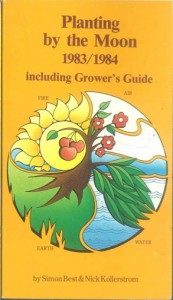 This gardeners’ calendar helps people to tune in to the life rhythms of Mother Earth. Our first Moon-calendar was done in 1980 as you can see.
This gardeners’ calendar helps people to tune in to the life rhythms of Mother Earth. Our first Moon-calendar was done in 1980 as you can see.
The book ‘Farmer’s Moon’ gives all of the experimental evidence on which this yearly biodynamic calendar about moon gardening is based.
Years of research show that both the monthly phase rhythm (its meeting with the Sun) and its orbit around the stars of the Zodiac are of vital importance to moon phase gardening. Thereby we can experience a connection between heaven and earth, soil and sky, as is used in modern Biodynamic calendars.
The British Considera website tries to look at evidence for the Biodynamic calendar; a lot of the data from lunar-gardening experiments I have done in the past, is stored on that site. The US BioDynamics Now! website may also be of interest.
Nostalgia: How it all began
A long time ago, at the Olympia Mind, Body, Spirit festival, a ‘lunar gardening’ stall. You can see Mr Simon Best there, he and I originally designed and published the Calendar, his wife Penny Thornton had a connection to Foulsham’s publisher, who agreed to publish it. (Simon Best has moved on, and now edits the alternative-medicine journal ‘Caduceus.’)
Royal approval?
Here is a press-release Foulsham’s put out on the subject!
Seven Sacred Moons
My Calendar uses the notion of seven sacred moons: civilized nations usually have some sacred/holiday dates linked normally to the New Moon, for this is a proper time to begin new enterprises. Thereby we can honor the Moons used for festivals in different cultures.
For example, for the year 2002, the Sacred Moons were:
Chinese New Year 12th February * Muslim New Year 15th March * Easter Sunday 31 March (after the F.M. on 28th) * Buddhist Wesak 26th May * Jewish New Year 7th September * Hindu New Year 4th November (Diwali on 3rd) * Muslim Ramadan, 6th November
These are all New-Moon events, except for Easter and Wesak which are Full Moon.
For comparison, here are those of 2014:
Sacred moons of 2014
Chinese New Year 31 Jan, Year of the Horse NM 30 Jan
Hindu New Year 31 March NM 30 March
Easter Sunday 20th April FM 15 April
Buddhist Wesak 14th May FM 14th May
Start of Ramadan 28th June NM 27th June
Jewish New Year 25th Sept NM 24th Sept
Hindu Diwali 23 October NM 23th Oct
Muslim New Year 26th November NM 22th Nov
NM- new moon, FM – full moon
The Chinese sensibly start the year at the New Moon nearest to the quarter-day called ‘Imbolc’ which falls on 3rd February. That seems a good time for the year to begin. Candlemas (Groundhog day in America) also falls then. Later on, Beltane arrives on May 5th. Pagans often get muddled up about this and think its May 1st but these ancient quarter-days are much older than the solar calendar-months used today. The Calendar includes these (solar-defined) quarter-days although on the whole it is mainly lunar: after all the Four Seasons begin on these quarter-days, don’t they?
A Guild of lunar-gardening calendar-composers
To help ensure you get the very best advice each year, a guild has been formed, of lunar-calendar composers, including (I am allowed to reveal) the Editor of America’s well-known Stella Natura (Sherry Widlfeuer) and Brian Keats who does his amazing Australian ‘Astro-calendar‘ and me. Brian Keats publishes weather forecasts for the year ahead, and his calendar puts a lot of emphasis on lunar declination (which I have never really been into); plus Mark Moodie, British Bio-Dynamic expert who runs the ‘Considera‘ website. 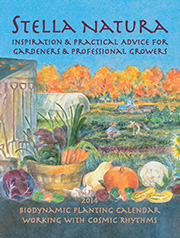
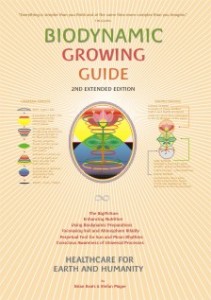
Not that it matters, but I was at one point the BBC’s ‘lunar gardening correspondent.’
Philosophy
New Alchemy means tuning into the living rhythms of Mother Earth. She holds the balance of the Four Elements. We exist as micro-organisms upon Her crust. Solar-lunar motions and cycles form a matrix from which life of Earth evolved. They do affect organic life.
Let’s quote from Dr Steiner’s Lectures on Agriculture given way back in 1925, which started off the whole thing:
There is a definite connection between the Moon and the water in the Earth. Let us therefore assume that there have just been rainy days and that these are followed by a full Moon. In deed and in truth, with the forces that come from the Moon on days of the full Moon, something colossal is taking place on Earth. These forces spring up and shoot into all the growth of plants, but they are unable to do so unless rainy days have gone before… we have to raise this question: How should we best consider the rainfall and the full Moon in choosing the time to sow the seed? For in certain plants, what the full Moon has to do will thrive intensely after rainy days and will take place but feebly and sparingly after days of sunshine. Such things lay hidden in the old farmers’ rules …
Various bits of evidence have since confirmed this deeply original viewpoint (see, Farmer’s Moon): that Selene’s Sphere has a maximal influence at the Full position – on all life-processes and fertility – which works through the water-element.
.
Here is a review of the Calendar by the late Alan Brockman, formerly Chairman of the UK’s Bio-Dynamic Agricultural Association, published in Resurgence, May 1999. (NB, the Calendar was a bit longer then than it is now)
This ‘Gardener’s Calendar’ is well presented and of a useful size, over 200 pages. Although described as a calendar, it is really two books in one.
A well-researched and comprehensive first section sets out very clearly the background and experiences, trials and results of working with planetary rhythms. The second section comprises a useful & easily understood guide to recommended work on the land & in the garden, day by day, throughout the year.
As we enter the space age in the new millennium, it is appropriate to enhance our appreciation of how life on earth is related to the heavens. This calendar, including as it does many references to ideas & sayings of the past, reminds us that we stand in an evolving world process, such as includes our our relationship to the plants & animals. Having gone through the phase where all talk of planting according to lunar cycles was viewed as ‘moonshine’ we are now approaching a new, scientifically-based appreciation of life-rhythms as linked to the cosmos.
The many examples of practical trials & results here presented, especially those carried out in the UK, can be a great help in showing those of a sceptical turn of mind that there is ‘something in it.’ These moon and other rhythms seem to be only really effective in connection with a ‘living’ soil i.e. one where organic methods have been practised. This bears out a statement by Rudolf Steiner (founder of the Bio-Dynamic method of growing) that mineral fertilisers make the soil ‘deaf.’
To organic growers the idea of working with moon & star-rhythms will make sense, as all life is carried on rhythms and life manifests through rhythms. The most immediate one is the diurnal cycle: the birds’ dawn chorus is the expression of the power-wave circling the earth with the rising sun. This surge of life becomes really noticeable in February and gradually fades in July, which leads to our experience of the year’s rhythm. Over the basic solar rhythm of the year is superimposed the moon’s rhythm, that of waxing and waning.
In earlier times shepherds would put the ram to the ewes when the moon was waxing, and take him off after full moon. We have often found that a whole flush of calves would be born around full moon time whilst the new moon period is much quieter. At full moon time especially in the summer, there is always an element of restlessness in nature. It is quite noticeable and many people experience this personally in sleeplessness.
A ‘moon-stamp’ has long been used on timber felled in the tropics to indicate that it was cut during the new moon period when the sap was down, so rotting and insect damage were at a minimum.
Our experience has been that working with these rhythms increases the keeping qualities of vegetables and flowers. Carrots kept markedly better if harvested at the right time (shown by controlled test at the Balk institute in Holland). BD work in Australia includes well over one million acres with desert being reclaimed in some areas. The sprays are delivered by aircraft and 2,000 acres can be treated with the homeopathic doses in one afternoon, to catch the Earth’s ‘in-breathing’ period of the day. Earlier herbalists were convinced of a connection of plants to planetary rulerships, e.g. Culpepper. Perhaps our task now is to understand these forces and work with them in a scientific way.
In this Calendar, Mr K. has made great efforts to put us in a position to do that. The chapters include, Perspectives, Cycles of the Sky, Moon and Fertility, Moon and Crop Yields, Using the Star-Zodiac, and Gardening Aspects. The Calendar uses the Star-zodiac, i.e. the Sidereal, as used to this day in India. His thorough review of the divisions of the zodiac will be a great help to newcomers in the field. On a thoroughly practical level, two sets of month-by-month work planned for the gardener are included: Ken Whyatt’s plan of work, and an eighteenth-century gardening year are
especially helpful guides and reminders. The final chapter ‘How to use the calendar in farm and garden’ is followed by the day by day calendar itself. A very readable book!
I used to work on Alan Brockman’s Bio-dynamic farm near Canterbury. We could discuss the Bio-dynamic calendar, and he would explain other arcane matters such as the elixirs prepared for his compost-heaps.
Here was a review in the Sunday Telegraph in 2000 (‘I’m prepared to give it a go’).
Here is a Renaissance English view of the topic from a few centuries ago:
To the better furthering of the gardener’s travails, he ought afore to consider, that the Garden earth be apt and good, wel turned in with dung, at a due time of the year, in the increase of the Moon, she occupying an apt place in the Zodiack, in agreeable aspect of Saturn, & well-placed in the sight of heaven … for otherwise his care and pains bestowed about the seeds and plants, nothing availeth the Garden.
Thomas Hill in The Gardener’s Labyrinth, 1577, Ch. 21
From a more astronomical viewpoint, here is a video of me speaking about the ‘mystery of the Moon’ at a 2012 ‘Over the Moon’ Festival, introduced by Lucy Whyatt. I always feel its such a fascinating subject.
An alchemical image of ‘lunar gardening’?

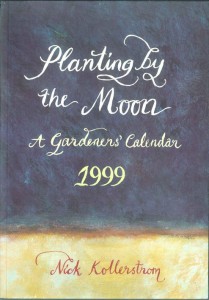
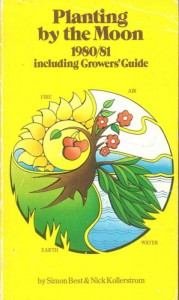

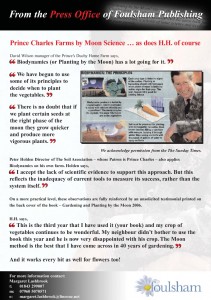
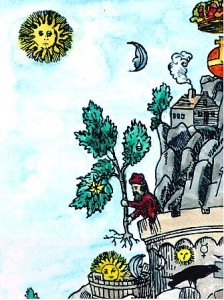


Leave a Reply